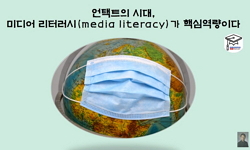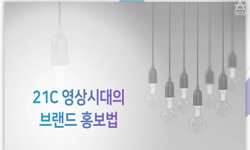This paper is about multi-literacies in contemporary art education with particular focus on stipulating digital video literacy to promote the benefits of digital storytelling. The growing importance of digital technology and new media in the field of ...
http://chineseinput.net/에서 pinyin(병음)방식으로 중국어를 변환할 수 있습니다.
변환된 중국어를 복사하여 사용하시면 됩니다.
- 中文 을 입력하시려면 zhongwen을 입력하시고 space를누르시면됩니다.
- 北京 을 입력하시려면 beijing을 입력하시고 space를 누르시면 됩니다.
부가정보
다국어 초록 (Multilingual Abstract)
This paper is about multi-literacies in contemporary art education with particular focus on stipulating digital video literacy to promote the benefits of digital storytelling. The growing importance of digital technology and new media in the field of art education cannot be ignored. Understanding more about the meaning making practices through digital video literacy by incorporating visual literacy, media literacy, and digital literacy is significant topic to discuss. Educating digital video literacy allows students to decipher, interpret, create and understand digital storytelling that is associated with digital technology. Chung (2006, 2007a) presents the possibilities of digital storytelling as a form of interdisciplinary education in art classrooms by arguing that "digital storytelling offers tremendous potential for integrating and teaching contemporary visual culture, greater issues of concern, and multimedia arts to the digital generation"in art education (Chung, 2006: 34). Chung (2006: 34) further elaborates on this notion by relating art education to today’s art. Digital storytelling is applicable to art education because it empowers "art learners to cultivate and apply their multiple literacy, artistic, and critical skills to voice their concerns or address greater issues of significance to an ever larger global audience" I also believe that digital storytelling can be implemented in order to educate students regarding a) critical thinking and discerning eyes, b) an understanding of art elements and principles of videos, c) storytelling through multi-literacies, and d) new types of self-representation, digital ethics and copyrights.
The proliferation of digital technologies become relevant to the teaching of contemporary art, and can offer pedagogically diverse aspects of literacies in digital media making. Depending on how those literacies are taught and introduced in art educational settings, students who are digitally literate can achieve competency in communicating with contemporary art. Educating students about this set of abilities (digital video literacy), where visual, digital, and media literacy overlap in digital art classrooms, would allow for new forms of communication, adaptation, understanding, and the transformation to students who are digital natives.
참고문헌 (Reference)
1 O’Rourke, M., "‘Engaging Students Through ITCs: A Multiliteracies Approach’" Knowledge Enterprise
2 Merchant, G., "Writing the future in the digital age" 41 (41): 118-128, 2007
3 Mahiri, J., "Writing for their lives: The non-school literacy of California's urban African American youth" 65 (65): 164-180, 1996
4 Boughton, D., "Visual literacy: Implications for cultural understanding through art education" 5 (5): 125-142, 1986
5 Fransecky, R., "Visual literacy: A way to learn—A way to teach" Association for Educational communications and Technology 1972
6 Duncum, P., "Visual culture: Developments, definitions, and directions for art education" 42 (42): 101-112, 2001
7 Duncum, P., "Visual culture isn’t just visual: Multiliteracy, multimodality and meaning" 45 (45): 252-264, 2004
8 Duncum, P., "Visual culture art education: Why, what and how" 21 (21): 14-22, 2002
9 Kress, G, "Visual and verbal modes of representation in electronically mediated communication: The potentials of new forms of text, in Page to screen: Taking literacy into the electronic age" Allen & Unwin 53-79, 1997
10 Cassidy. M., "Visual Literacy: A failed metaphor" 31 : 67-90, 1983
1 O’Rourke, M., "‘Engaging Students Through ITCs: A Multiliteracies Approach’" Knowledge Enterprise
2 Merchant, G., "Writing the future in the digital age" 41 (41): 118-128, 2007
3 Mahiri, J., "Writing for their lives: The non-school literacy of California's urban African American youth" 65 (65): 164-180, 1996
4 Boughton, D., "Visual literacy: Implications for cultural understanding through art education" 5 (5): 125-142, 1986
5 Fransecky, R., "Visual literacy: A way to learn—A way to teach" Association for Educational communications and Technology 1972
6 Duncum, P., "Visual culture: Developments, definitions, and directions for art education" 42 (42): 101-112, 2001
7 Duncum, P., "Visual culture isn’t just visual: Multiliteracy, multimodality and meaning" 45 (45): 252-264, 2004
8 Duncum, P., "Visual culture art education: Why, what and how" 21 (21): 14-22, 2002
9 Kress, G, "Visual and verbal modes of representation in electronically mediated communication: The potentials of new forms of text, in Page to screen: Taking literacy into the electronic age" Allen & Unwin 53-79, 1997
10 Cassidy. M., "Visual Literacy: A failed metaphor" 31 : 67-90, 1983
11 Bamford, A., "The visual literacy white paper"
12 Duncum, P, "The theories and practices of visual culture in art education" 105 (105): 19-25, 2003
13 Goodman, K. S., "The psycholinguistic nature of the reading process" Wayne State University Press 1968
14 Freedman, K., "Teaching visual culture: curriculum, aesthetics, and the social life of art" Reston 2003
15 Masterman, L., "Teaching the media" Comedia/MK Press 1985
16 Schwarz, G., "Overview: What is media literacy, who cares, and why? In Media literacy: Transforming curriculum and teaching" National Society for the Study of Education 5-17, 2005
17 Clark, M. C., "Off the beaten path: Some creative approaches to adult learning" 89 : 83-91, 2001
18 Nixon, H., "New research literacies for contemporary research into literacy and new media" 38 (38): 407-413, 2003
19 Lankshear, C., "New literacies: Changing knowledge and classroom learning" Open University Press 2003
20 Chung, S, K., "Media/Visual literacy art education: Sexism in Hip-Hop music videos" 60 (60): 33-38, 2007
21 Chung, S, K., "Media/ Visual literacy art education: Cigarette ad deconstruction" 58 (58): 18-23, 2005
22 Hobbs, R., "Media literacy skills: interpreting tragedy. (Reflections in a time on crisis)" 65 (65): 406-411, 2001
23 Buckingham, D., "Media education: Literacy, learning and contemporary culture" Polity Press 2003
24 Livingstone,S., "Media Literacy and the Challenge of New Information and Communication Technologies" (7) : 3-14, 2004
25 Lonsdale, M, "Literacy in the new millennium" National Center for Vocational Education and Research
26 Rafferty, D., "Literacy in the information age" 57 (57): 22-23, 1999
27 Collins. J., "Literacy and literacies: Text, power, and identity" Cambridge University Press 2003
28 Eshet-Alkali, Y., "Experiments in digital literacy" 7 (7): 421-430, 2004
29 BECTA, "Emerging technologies for learning"
30 "EU media literacy Questionnaire. Answers from the international clearinghouse on children, youth and media"
31 Miller, C., "Digital storytelling: a creator’s guide to interactive entertainment" Elsevier 2004
32 Meadows, D., "Digital storytelling: Research-based practice in new media" 2 (2): 189-193, 2003
33 Ohler, J., "Digital storytelling in the classroom" SAGE 2008
34 Chung, S. K., "Digital storytelling in integrated arts education" 4 (4): 33-63, 2006
35 Digital Storytelling Association, "Digital storytelling"
36 Eshet, Y., "Digital literacy: A new terminology framework and its application to the design of meaningful technology-based learning environments, in Proceedings of World Conference on Educational Multimedia, Hypermedia and Telecommunications" AACE 493-498, 2002
37 Gilster, P., "Digital literacy" Wiley 1998
38 O’ brien, D., "Digital literacies go to school: Potholes and possibilities" 52 (52): 66-68, 2008
39 Lambert, J., "Digital Storytelling. Capturing Lives, Creating Community (2nd ed.)" Digital Diner Press 2006
40 Freedman, K., "Curriculum change for the 21st century: Visual culture in art education, in Handbook of research and policy in art education" NJ:Lawrence Erlbaum Associates 2004
41 Kellner. D., "Critical Media Literacy is Not an Option, in Learning Inquiry" Springer 2007
42 Jones-Kavaller, B., "Connecting the digital dots: Literacy of the 21st century" 2 : 8-10, 2006
43 Goodson, I.F., "Computer literacy as ideology" 17 : 65-79, 1996
44 Davis, A., "Co-Authoring Identity: Digital Storytelling in an Urban Middle School"
45 Flood, J., "Broadening the lens: Toward an expanded conceptualization of literacy, In Perspectives on literacy research and practice" National Reading Conference 1-16, 1995
46 Bolin, P., "Beyond visual culture: Seven statements of support for material culture studies in art education" 44 (44): 246-263, 2003
47 Chung, S. K., "Art education technology: Digital storytelling" 60 (60): 17-22, 2007
48 New London Group, "A pedagogy of multiliteracies: Designing social futures" 66 (66): 60-92, 1996
49 Educause Learning Initiative, "7things you should know about digital storytelling, p.1-2"
동일학술지(권/호) 다른 논문
-
입체표현활동에서 나타나는 유아의 또래 간 교수-학습에 관한 현상학적 연구
- 한국조형교육학회
- 장유진
- 2011
- KCI등재
-
창의적 미술 수업을 위한 창의적 미술교사의 현장연구방법 - 미술을 중심으로 한 연구법 (art-based action research) -
- 한국조형교육학회
- 김미남
- 2011
- KCI등재
-
- 한국조형교육학회
- 윤민희
- 2011
- KCI등재
-
‘가르치는 예술가’ 윤현옥의 미술과 교육 프로젝트 연구
- 한국조형교육학회
- 안인기
- 2011
- KCI등재
분석정보
인용정보 인용지수 설명보기
학술지 이력
| 연월일 | 이력구분 | 이력상세 | 등재구분 |
|---|---|---|---|
| 2027 | 평가예정 | 재인증평가 신청대상 (재인증) | |
| 2021-01-01 | 평가 | 등재학술지 유지 (재인증) |  |
| 2018-01-01 | 평가 | 등재학술지 유지 (등재유지) |  |
| 2015-01-01 | 평가 | 등재학술지 유지 (등재유지) |  |
| 2011-01-01 | 평가 | 등재학술지 유지 (등재유지) |  |
| 2009-01-01 | 평가 | 등재학술지 유지 (등재유지) |  |
| 2007-01-01 | 평가 | 등재학술지 유지 (등재유지) |  |
| 2006-07-24 | 학회명변경 | 영문명 : Society For Art Education Of Korea -> Society for Art Education of Korea |  |
| 2005-06-15 | 학술지등록 | 한글명 : 조형교육외국어명 : ART EDUCATION REVIEW |  |
| 2004-01-01 | 평가 | 등재학술지 선정 (등재후보2차) |  |
| 2003-01-01 | 평가 | 등재후보 1차 PASS (등재후보1차) |  |
| 2002-01-01 | 평가 | 등재후보 1차 FAIL (등재후보1차) |  |
| 2001-01-01 | 평가 | 등재후보학술지 선정 (신규평가) |  |
학술지 인용정보
| 기준연도 | WOS-KCI 통합IF(2년) | KCIF(2년) | KCIF(3년) |
|---|---|---|---|
| 2016 | 0.86 | 0.86 | 0.84 |
| KCIF(4년) | KCIF(5년) | 중심성지수(3년) | 즉시성지수 |
| 0.82 | 0.76 | 0.941 | 0.28 |




 KCI
KCI 스콜라
스콜라






